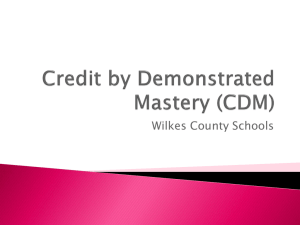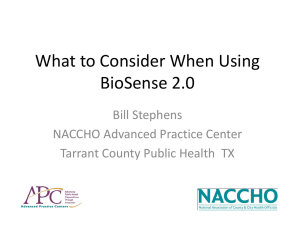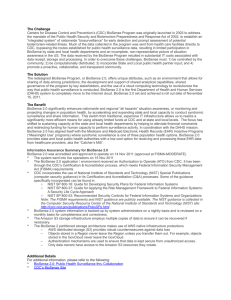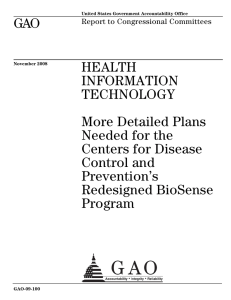CDM Data Analytics Using a RIM approach
advertisement
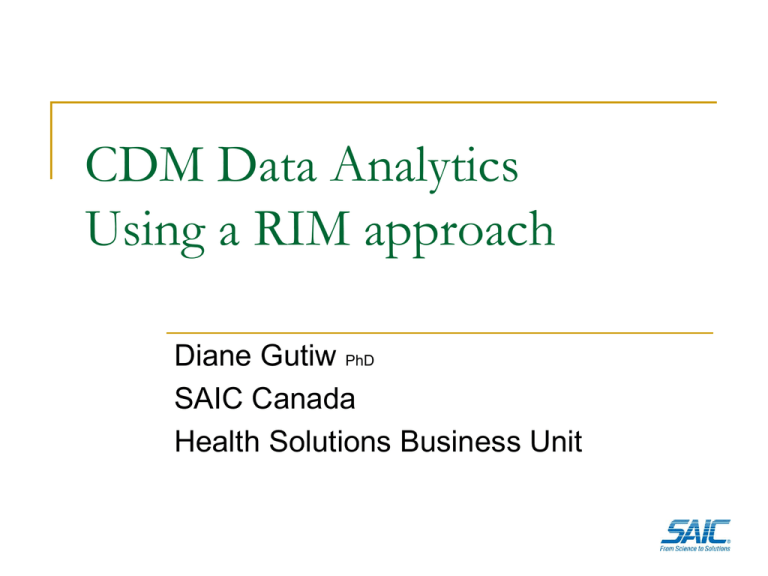
CDM Data Analytics Using a RIM approach Diane Gutiw PhD SAIC Canada Health Solutions Business Unit CDM Data Analytics Discussion … The Business Problem Overview of CDM Workflow Overview of the need for Data Analytics Support in V3 messaging and RIM How to implement BioSense as potential solution for CDM The CDM Business Problem Multiple disease conditions Diabetes, CHF, COPD, HBP, Asthma, Renal, Depression, Arthritis, Alzheimer's, Epilepsy, Hepatitis, CF, Eating Disorders, Obesity, Cancer, Anemia, AIDS/HIV etc. May be overlap in conditions Treatment focus is disease management not cure CDM Clinician collaboratives Data sharing based on treatments and outcomes rather than POS data Challenges of data collection Challenges of data standardization/normalization Potential Data Sources Drug Repository EMR EMR EMR SHR RIM Lab Repository Pharmacy Pharmacy ADT ADT Provider Location Repository Repository Client Registry DI Repository Immunization Repository CDM Workflow Collaborate Protocols Outcomes Treatment Assessment Diagnose Condition Support in Messaging Supporting Messages: Lab Diagnostic Imaging Immunization Prescription ADT … Gaps identified in existing reporting for CDM Gaps in HL7 v3 Messaging Use existing Registries/Repositories as “source of truth” CDM elements available in RIM Clinical data specific to CDM not in any existing RMIM Data required for CDM Analytics outside of existing repositories: Clinical background (smoking cessation, diet, weight loss) all available in SNOMED Concept of Collaborative Teams Includes combined assessment, referrals, treatment, hospitalizations and adjusted treatment pattern for CDM Treatment refusals, testing negation indicators and lifestyle adjustments/refusals critical to data analytics And then how to consolidate data and extract for “meaningful use”? Benefits of a RIM-based solution Supports data modeling requirements Supports standardization Supports normalization Extends to multiple conditions, treatments, outcomes Supports reporting needs BioSense Solution BioSense Solution: To provide a technology platform which simplifies the enablement of public health reporting in a healthcare-centric environment, satisfying the requirements of HITECH and “meaningful use” objectives relative to Public Health. BioSense Architecture A toolset that can be run standalone, or can be integrated into an existing system or system interface. An interface that allows loose coupling. This allows it to be integrated into proprietary platforms such as Microsoft .NET. A design to support Public Health reporting, and flexible enough to support future health reporting requirements. Interoperable Hardware and software vendor independent. Able to collect appropriate and targeted hospital/jurisdictional data. BioSense System Rhapsody Secure Messaging The Integrator “listens” to the source’s HL7 traffic and places needed data on-line Provides a guaranteed message delivery service across the internet Integrator POS Hospitals & Clinics Data Broker Rhapsody Receives source data, un-batches and transforms HL7 files to XML & send XML to queue Extract, Transform, Load (ETL) Informatica Apply business rules to data and load Data Warehouse Secure Data Network POS Labs Provides Certificate based authentication services Retail Pharmacy Rx Application Public Health Users And CDM Users Bio-Intelligence Users Data Marts SAS WebLogic ESRI LifeRay Portal Application specific, de-normalized & decentralized data SAS Analytics 12 Data Warehouse Centralized Data Repository Example: Stand-alone Solution for Surveillance PHORS leverages SAIC’s healthcare and HL7 messaging knowledge. The PHORS architecture is designed to allow Infection Control Practitioners (ICPs) to define detection rules which are then stored in a rules based engine and used by web services to identify patient data to assist ICPs in managing and reporting of Hospital Acquired Infections (HAI) Public Health Open Reporting System (PHORS) NATIONAL HEALTH SAFETY NETWORK BIOSENSE ELR BIOSENSE 13 BioSense Features Configurable by the end user You select the characteristics of the records Controllable by the end user Additional reporting available Can require user approval prior to reporting 14 Can add other characteristics or reports for local needs Supports a multitude of data feeds Next Steps…. BioSense currently in production in US for Public Health BioSense currently receives > 4 million clinical records daily Batch (Not Real Time) 913 Veterans Affairs (VA) facilities 375 Department of Defense (DOD) facilities Real Time 117 facilities from 24 Hospital Systems 536 facilities from 9 Syndromic Systems 2 National Reference Labs (LabCorp and Quest) >35,000 retail pharmacies (PerSe, McKesson RelayHealth) BioSense to be presented to Canadian Public Health and CDM business users BioSense to be adapted to meet CDM requirements as POC Questions or follow up … Diane Gutiw gutiwd@saic.com


